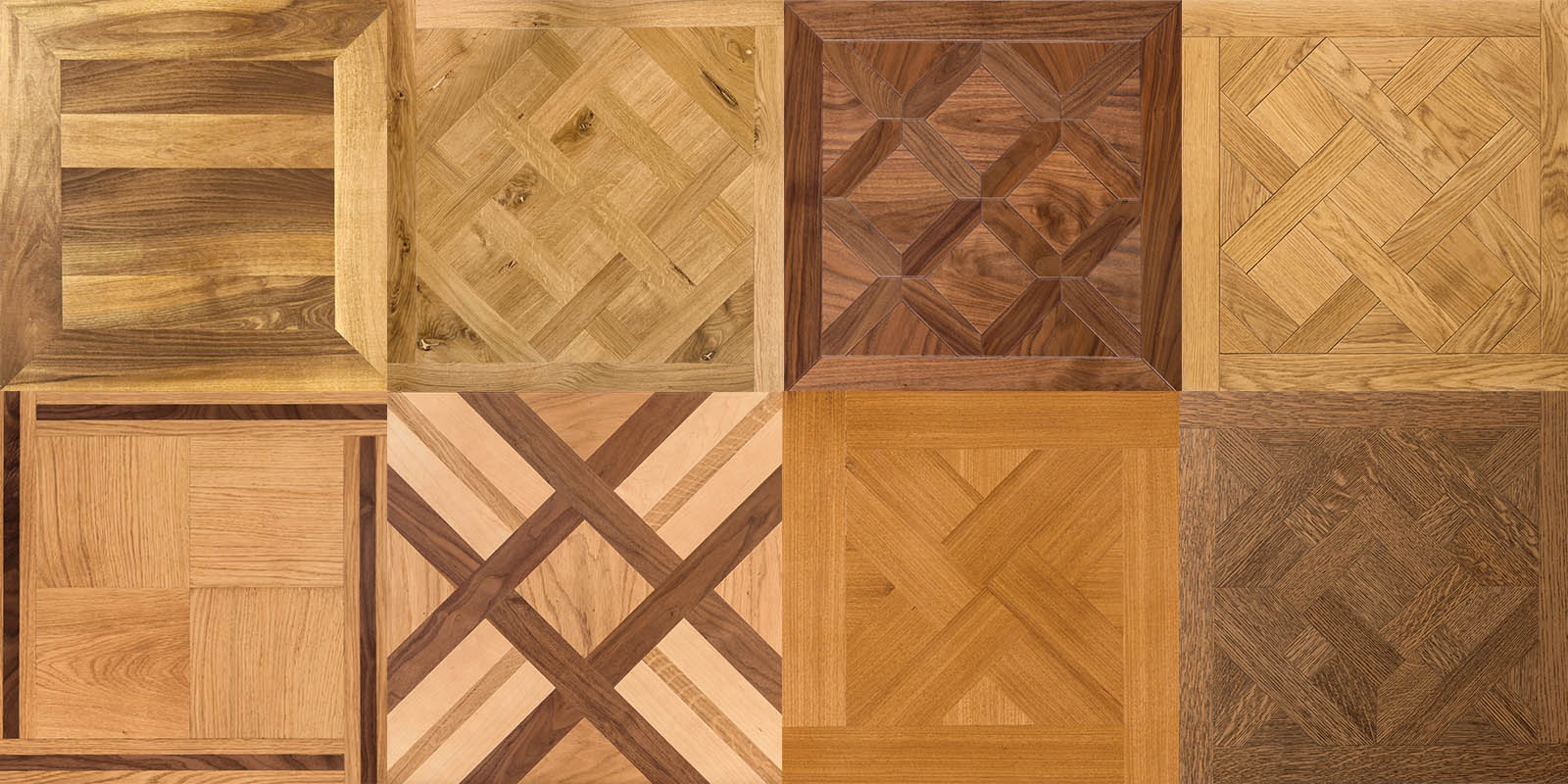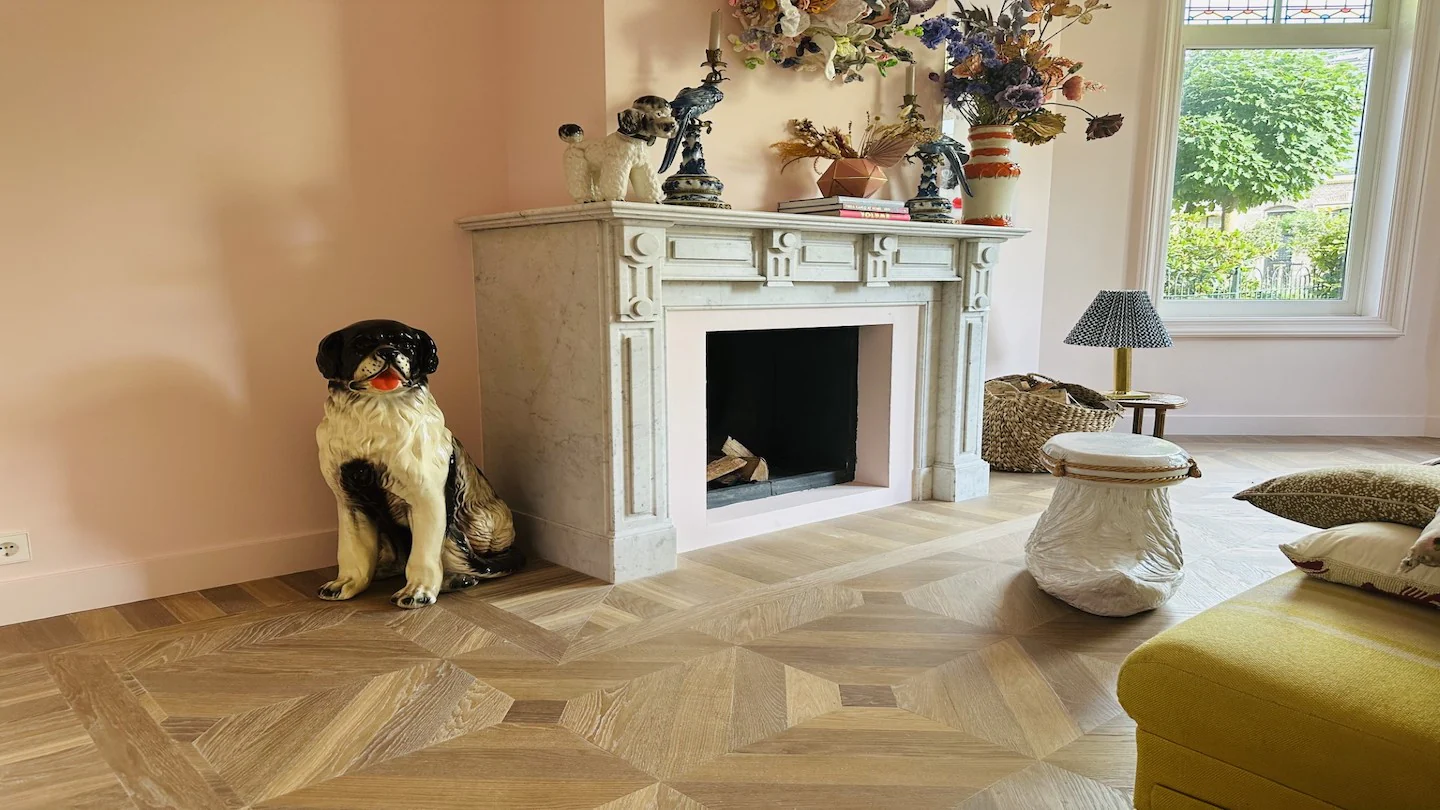Table of Contents
ToggleUnderstanding Custom Parquet Flooring
Custom parquet flooring is a type of engineered wood flooring where individual pieces of wood are arranged in intricate patterns to create a visually appealing and unique surface.
Unlike traditional plank flooring, parquet flooring emphasizes geometric designs and artistic layouts. Each piece of wood is carefully cut and fitted together, creating a mosaic-like effect that adds depth and character to any room.
This flooring style combines the natural beauty of wood with the precision of craftsmanship, resulting in a bespoke look tailored to the specific aesthetic preferences of the homeowner.
Common Materials Used
Custom parquet flooring is typically crafted from high-quality hardwoods and engineered wood products. Some of the most popular materials include:
- Oak: Used due to its ageless beauty and reputation for strength and eye-catching grain patterns.
- Walnut: Prized for its deep, dark hue and exquisite texture, lends a refined touch to parquet patterns.
- Maple: Maple’s light tone and smooth texture give it a modern, tidy appearance.
- Cherry: Cherry wood’s warm tones and smooth finish make it ideal for creating inviting, luxurious spaces.
- Exotic Woods: Species like mahogany, teak, and wenge are used for their unique colors and patterns, offering a truly distinctive appearance.
Popular Patterns and Designs
Custom parquet flooring allows for a variety of patterns and designs, each offering a different visual effect. Some popular patterns include:
- Herringbone: A classic design where rectangular pieces are laid in a zigzag pattern, creating a sense of movement and elegance.
- Chevron: Designs are elegant and refined, resembling herringbone but with a more precise, V-shaped pattern.
- Basket Weave: This pattern has a rough and detailed surface, emulating the appearance of weaved baskets.
- Versailles: Named after the famous French palace, this pattern features a complex arrangement of squares and rectangles, evoking a sense of grandeur and opulence.
- Mosaic: Custom designs that can incorporate various shapes, sizes, and wood species to create artistic and personalized motifs.
Benefits of Customization
Choosing custom parquet flooring offers several advantages:
- Unique Aesthetics: Custom parquet designs provide a one-of-a-kind look that can be tailored to match the architectural style and interior decor of any space.
- Personal Expression: Homeowners can select patterns, wood species, and finishes that reflect their personal taste and lifestyle.
- Enhanced Property Value: Because custom parquet flooring is made to order, it’s an investment worth making because it can raise a property’s total value.
- Versatility: Custom parquet flooring can be designed to fit any room size or shape, offering flexibility in both residential and commercial applications.
- Durability: Engineered wood parquet is highly durable and stable, resistant to warping and shrinking, making it suitable for various environmental conditions.

Exploring Traditional Hardwood Flooring
A single piece of timber is cut into solid wood planks for traditional hardwood flooring. Each plank is typically ¾ inch thick, providing a robust and long-lasting flooring option. The inherent grain and texture of the wood are highlighted in this style of flooring, which may be repeatedly sanded and refinished to increase its longevity.
Common Wood Species
Numerous wood species are used to make traditional hardwood flooring, and each has special traits and aesthetic appeal of its own:
- Oak: One of the most popular choices due to its durability and prominent grain patterns. Oak comes in red and white variations, each with unique colors and styles.
- Maple: Known for its light color and fine grain, maple provides a sleek and modern appearance that suits contemporary interiors.
- Cherry: Cherry wood features rich, reddish-brown hues that deepen over time, adding warmth and sophistication to any room.
- Walnut: Valued for its dark, luxurious color and straight grain, walnut creates an elegant and formal look.
- Hickory: With its distinctive grain patterns and color variations, hickory is a strong and resilient option that adds rustic charm.
- Birch: Birch offers a pale, smooth finish with a subtle grain, ideal for a clean and understated aesthetic.
Traditional Installation Methods
Traditional hardwood flooring installation involves several methods, each suited to different types of subfloors and preferences:
- Nail Down: With this procedure, a wooden subfloor is immediately nailed to the hardwood planks.
- It is one of the most common and secure methods, providing a stable and long-lasting installation.
- Staple Down: Similar to the nail-down method, this technique uses staples instead of nails to attach the planks to the subfloor. It is often quicker and can be easier for DIY installations.
- Glue Down: In this method, a strong adhesive is used to bond the hardwood planks directly to the subfloor, suitable for both concrete and wooden subfloors. This provides a firm and quiet floor.
- Floating: The planks are not attached to the subfloor but are instead connected, usually with a tongue-and-groove system, and laid over an underlayment. This method allows for slight movement and is ideal for areas with fluctuating humidity levels.
Timeless Appeal and Natural Beauty
Traditional hardwood flooring has a timeless appeal that transcends trends and continues to be a favorite among homeowners and designers. Its natural beauty lies in the unique grain patterns, textures, and colors inherent in each plank, providing a sense of warmth and authenticity that is hard to replicate with other materials. The ability to sand and refinish traditional hardwood floors means they can be restored to their original glory, even after decades of use, ensuring their enduring charm and value.
Whether used in a cozy living room, an elegant dining area, or a sleek office space, traditional hardwood flooring enhances the aesthetic appeal and adds a touch of sophistication.

Key Differences Between Custom Parquet and Traditional Hardwood
Design Flexibility
- Custom Parquet Flooring: Offers unparalleled design flexibility with the ability to create intricate patterns and unique layouts. Popular designs include herringbone, chevron, basket weave, and mosaic patterns. This enables homeowners to customize their flooring to fit their preferred aesthetics and interior design themes, giving each installation a one-of-a-kind look that is specific to the room.
- Traditional Hardwood Flooring: While traditional hardwood flooring provides a classic and timeless look, its design options are generally limited to the natural grain and color variations of the wood. The primary aesthetic choice lies in the selection of wood species and plank width. It offers a more uniform and consistent appearance, which can be ideal for those seeking a simpler, more traditional look.
Installation Process
- Custom Parquet Flooring: Installation of custom parquet flooring is more complex and time-consuming due to the intricate patterns and precise fitting required. To guarantee that every component is properly aligned and fastened, expert installation is frequently required.
- This meticulous process can take longer and may involve additional steps such as creating detailed layouts and custom cutting pieces to fit specific designs.
- Traditional Hardwood Flooring: There are several ways to install traditional hardwood flooring, including floating, glue-down, staple-down, and nail-down.
- These methods are generally more straightforward and can be completed more quickly than custom parquet installations. Certain techniques, like floating floors, can be easier to do yourself, even if expert installation is advised for the best results.
Durability and Maintenance
- Custom Parquet Flooring: Custom parquet flooring is highly durable, especially when made from high-quality hardwoods or engineered wood. If damaged, though, its elaborate designs may make repairs more difficult. Maintenance entails routine cleaning and sporadic refinishing to maintain the surface’s best appearance.
- Due to the precision required in the patterns, repairs might necessitate professional attention to maintain the integrity of the design.
- Traditional Hardwood Flooring: Conventional hardwood floors are renowned for their toughness and can have several sandings and refinishes to greatly increase their lifespan.
- They are generally easier to repair and maintain, with individual planks being replaced more straightforwardly. Regular maintenance includes sweeping, mopping, and periodic refinishing to preserve the wood’s natural beauty.
Cost Considerations
- Custom Parquet Flooring: The cost of custom parquet flooring is typically higher due to the complexity of the design, the quality of materials, and the specialized installation process. The intricate patterns require more labor and precision, contributing to higher installation co Furthermore, using different wood species and creating unique designs may raise the final cost.
- Traditional Hardwood Flooring: Traditional hardwood flooring is generally more cost-effective compared to custom parquet. The straightforward installation process and the availability of pre-finished planks can reduce both material and labor costs. While high-quality hardwoods can still be expensive, the overall cost tends to be lower than custom parquet flooring, making it a more budget-friendly option for many homeowners.
Conclusion
In summary, custom parquet and traditional hardwood flooring each offer distinct advantages and challenges. Custom parquet provides unparalleled design flexibility and a unique aesthetic but comes with higher costs and a more complex installation process. Traditional hardwood flooring offers timeless appeal, easier installation, and maintenance at a generally lower cost, making it a versatile and enduring choice for many spaces.
